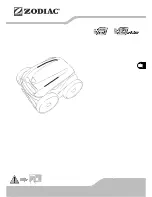
P a g e
|
17
hypochlorite, liquid chlorine or trichlor) to quickly raise the level of chlorine. When the chlorine level is quickly
raised to 5 - 15 ppm the pool water is said to have been shocked.
NOTE
On initial startup of a pool, it is best to shock from either a shock treatment or a registered or scheduled source of
sodium dichlor, calcium hypochlorite, liquid chlorine or trichlor available at your local pool supplier..
CAUTION
Never use dry acid to adjust pH in arid geographic areas with excessive evaporation and minimal dilution of pool water
with fresh water. A buildup of by-products can damage the electrolytic cell.
• The
pH
condition resulting from the operation of a salt water chlorination system is close to neutral. However, other
factors usually cause the pH of the pool water to rise. Therefore, the pH in a pool chlorinated by a salt water system
tends to stabilize at approximately 7.6. If the pool pH rises above 7.6 have a pool professional test to see if other
factors such as high calcium hardness or total alkalinity are the cause and then balance accordingly.
•
Total Dissolved Solids
(TDS) Adding salt to pool water will raise the TDS level. While this does not adversely
affect the pool water chemistry or clarity, the pool water professional testing for TDS must be made aware salt has
been added for the sanitizing system. The individual performing the TDS test will then subtract the salinity level to
arrive at the correct TDS level.
•
New pool water
in a recently filled or newly refinished pool may contain undesirable matter which could interfere
with the salt water chlorinator’s ability to sanitize properly. Make sure the water is tested by a pool professional and
properly balanced before turning on the chlorinator system. New plaster pools have a constant acid demand for six (6)
months. Test often and maintain a proper pH to avoid excess scaling of the cell.
•
Sequestering Agents
can be used to compensate for source water which may have unusually high calcium hardness.
High calcium hardness can contribute to scale formation in the pool. Sequestering agents will help keep minerals in
solution and under some conditions can prevent scaling from happening. Consult your pool professional about the use
of a sequestering agent.
4.4 Optimum Pool Water Conditions
In accordance with Association of Pool and Spa Professionals (APSP) standards, we recommend the following water
balance conditions be maintained on an on-going basis to protect the pool finish and the equipment and to ensure the
pleasing appearance of the water. The Zodiac AquaPure Ei Series APURE35PLGC is warranted to operate properly only
if the following conditions are met:
Free Available Chlorine
1.0 - 3.0 ppm.
pH
7.2 - 7.6
Total Alkalinity
100 - 120 ppm
Calcium Hardness
200 - 300 ppm
Salt
4000-4500 ppm
Cyanuric Acid
10 - 50 ppm (for outdoor pools only)
4.5 Chlorine Testing
Use a home test kit or ask your pool professional to test your water. Check the expiry date of the test kit as test results
may be inaccurate if used after that date. It is recommended that chlorine test samples be taken from two (2) places,
described below. Compare the two (2) samples. A higher level should be found at the pool return line. The higher level at
the pool return line indicates the salt water chlorinator system is producing chlorine. If additional chlorine is required due to
heavy bather loads, use
sodium dichlor, calcium hypochlorite, liquid chlorine or trichlor
to maintain an appropriate
chlorine/bromine residual in the water.
















































